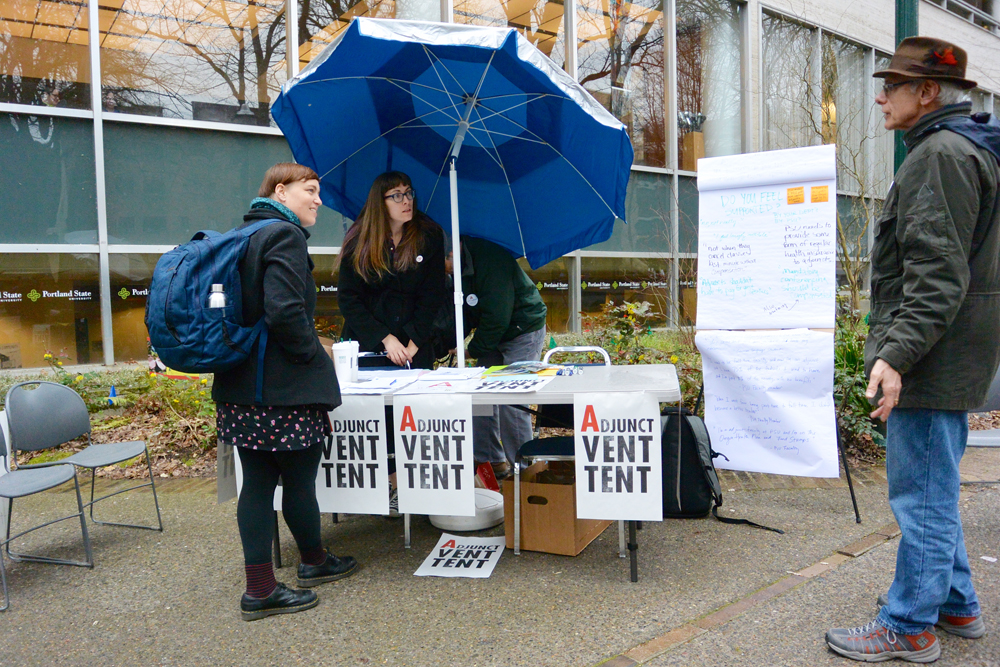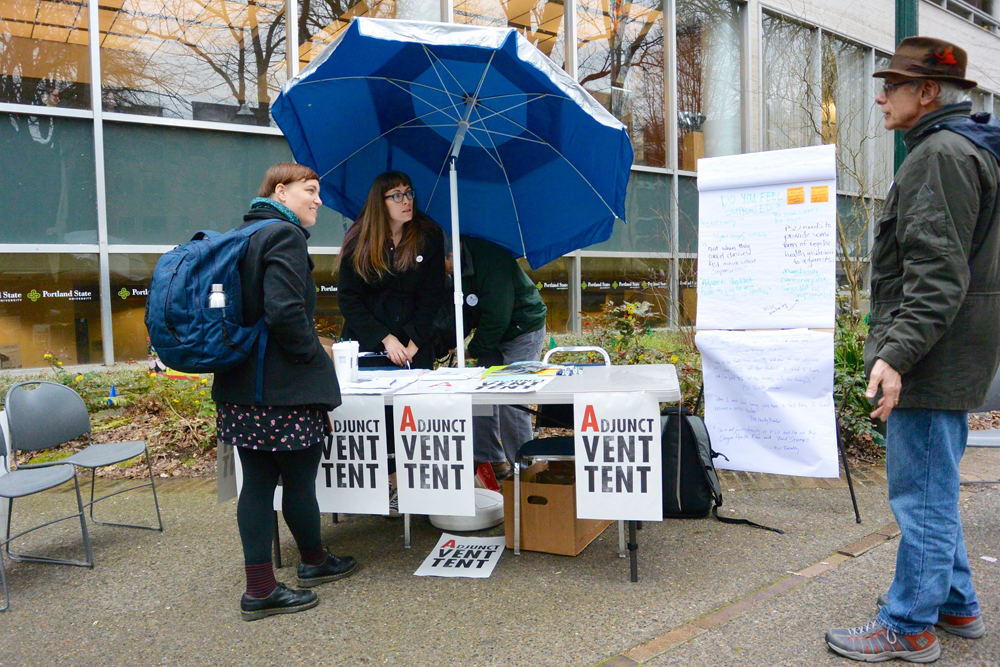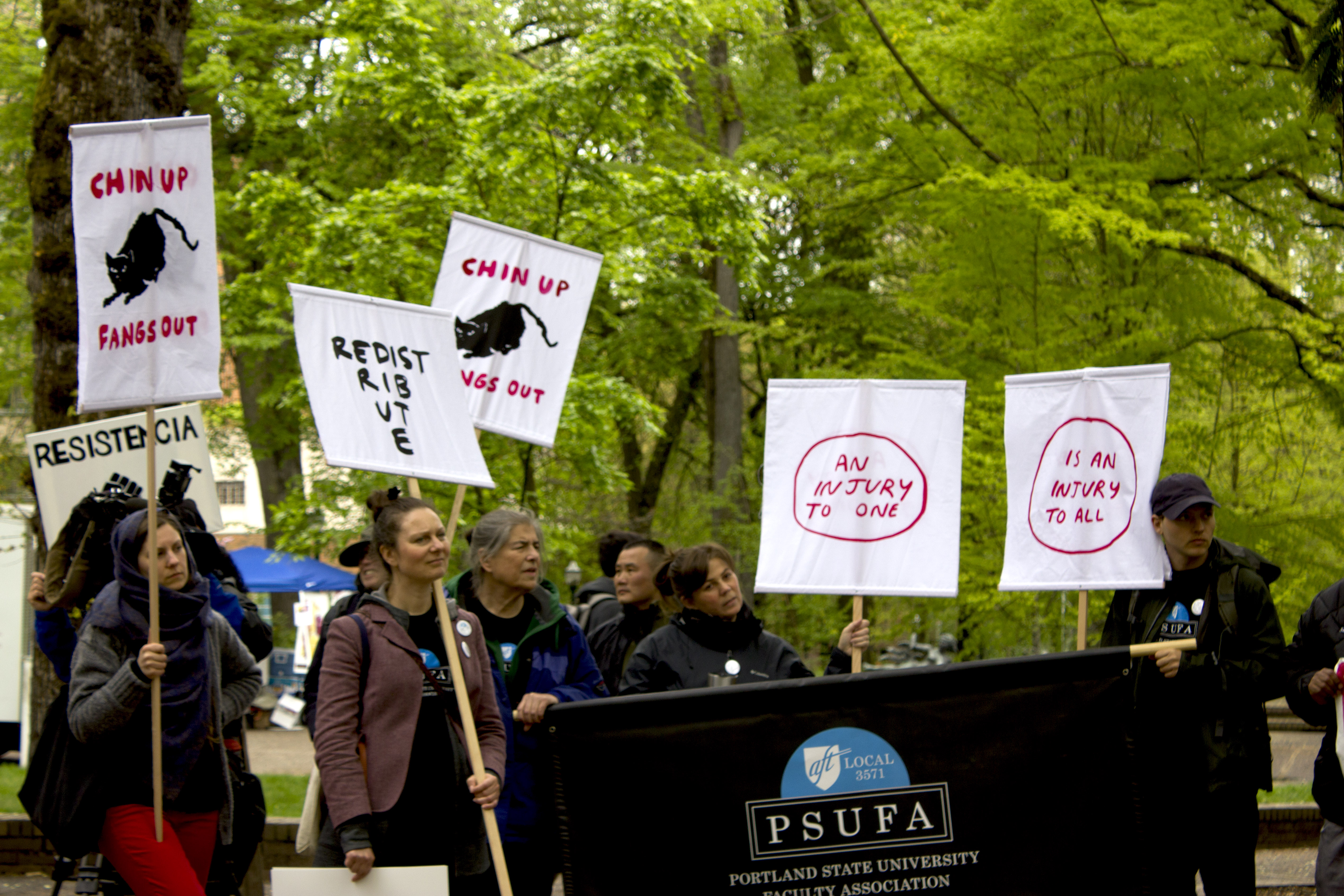The first ever National Adjunct Walkout Day took place last week on Wednesday, Feb. 25. The event aimed to raise awareness of unfair labor practices that adjunct instructors face at universities nationwide.
Anna Gray, adjunct instructor in the School of Art and Design at Portland State, helped organize PSU’s NAWD event along with Davida Jordan, who teaches in the Intensive English Language Program.
Several terms are used to describe higher education instructors who are contracted on a short-term basis. At PSU, they are most often referred to as adjunct or fixed-term instructors. They may also be described as non-tenure track faculty. Nationally, and by AAUP, they are most often described as contingent employees.
According to the American Association of University Professors’ 2012–13 Economic Status Annual Report, 75 percent of the nation’s higher education teaching faculty is made up of contingent employees.
Gray talked about what it is like to be an adjunct instructor.
“It means flexibility, no official obligations for service work in your department,” she said. “It means maybe you get summers off, and it means a general sense of precarity making close to poverty wages with little to no job security. It means that you have to re-apply for your job every year. It means you might not know if you are teaching until a few weeks before a term starts.”
Jacqueline Arante, AAUP-PSU vice president for organizing and membership development, is the most senior adjunct instructor at PSU.
“I’ve been here since 1981,” she said. “The first nine years [I] worked as a freeway flyer and a ‘road scholar.’ In one term, I taught two courses here, two courses at [Portland Community College] and two courses at University of Portland. And my office was in my trunk.”
Arante continued, “You can’t be essential and be an adjunct.”
David Rives, president of the American Federation of Teachers-Oregon, said that though the original purpose of using adjuncts was to allow industry professionals to provide their expertise to students, that is no longer the case.
“The primary reason is to save money,” he said. “That’s really what it is.”
“It keeps their doors open,” Arante said. “It’s money, absolutely money. They’ve got a huge group of people they don’t have any committment to. And the word they would use to describe it is ‘flexibility.’”
According to an October 2014 article published by the online newspaper Inside Higher Education, the idea of a national walkout was conceived by an adjunct instructor at San Jose State. The instructor asked to remain unnamed due to job security concerns.
NAWD is not a centrally-organized movement, and according to PBS, the movement gained momentum on social media.
Universities and colleges across the country participated in the event. According to AAUP’s website, 29 AAUP chapters participated in the day, including PSU and Oregon State. Participants “conducted tabling, held teach-ins, lobby days, film screenings, and other
activities.”
PSU participated by setting up two “vent tents”—one at the PSU Urban Center and one on the Park Blocks.
NAWD, Rives said, aimed to raise awareness about working conditions for adjuncts, who make up the majority of teaching staff at universities and colleges across the country.
Gray clarified that PSU’s participation was not a protest.
“I consider this a consciousness and solidarity-building event and a prelude to building a strong contract campaign to support our bargaining efforts,” she said.
The contract for members of the Portland State University Faculty Association, the AFT-associated union for part-time teachers and research associates, expires on June 30, 2015. Contract negotiations, according to the AAUP website, are set to begin in May.
Adjuncts at PSU
In 2011, the Vanguard reported that there were roughly 676 adjunct instructors at PSU.
PSUFA and PSU reached an agreement over part-time faculty contracts in November 2013 according to a press release from Scott Gallagher, director of communications at University Communications.
In the press release, Gallagher reported that 887 employees, including adjuncts and research appointments, were covered by the PSUFA collective bargaining agreement.
According to Kathi Ketcheson, Director of PSU’s Office of Institutional Research and Planning, there were 695 fixed-term or adjunct instructors in Fall 2014, which is 45 percent of the instructional faculty at PSU. OIRP also reported that 31 percent of credit hours in fall term 2014 were taught by adjuncts. Ketcheson noted that many adjunct instructors only teach one class per term.
PSUFA representation includes “those employed less than half time (0.5 FTE) during the academic year, and those employed during summer terms who have been a member of the bargaining unit during the previous academic year,” according to the current collective bargaining agreement between PSUFA and PSU.
PSU-AAUP represents faculty who are 0.5 FTE or more, including contingent or fixed-term faculty. At PSU, faculty are determined to be either full or part-time based on a metric called Full Time Equivalency or FTE. 1.0 FTE is 45 credit hours per academic year, and those who teach part-time teach 22 credits a year or less. This is a little less than two classes per term over three terms.
PSUFA members receive $858 per credit as of winter term 2015. If an adjunct were to teach at .49 FTE, about 22 credits, at $858 per credit, adjuncts can make, at the most, $18,876.
“I was figuring out, in teaching two courses, how much I’m making per hour, and it comes out to $9.27 an hour,” Arante said. “That’s conservative, because that’s based on a 40-hour work week, and I spend more than 40 hours, because I’m teaching writing courses.”
The collective bargaining agreement also stipulates a $175,000 health insurance fund for PSUFA-represented employees each fiscal year. According to the agreement, “This fund will be used to attain a plan, or for partial payment in attaining a health insurance plan.”
For 887 employees, however, that amounts to less than $200 per person. Rives said not everyone uses the stipend.
“Most adjunct [instructors] don’t have employer-provided health insurance,” Rives said.
“Though the stipend PSU offers does help,” he continued, “it doesn’t at all go toward the whole cost, anything near what an employer-sponsored plan would provide.”
“You can get some not very adequate healthcare if you wrack up enough hours,” Arante said. “But it’s not decent healthcare.”
The agreement states that part-time faculty are hired on a fixed-term basis in which they may be contracted for the year. This does not guarantee classes every term of their contract, and they only receive compensation for the credit hours taught.
PSU is additionally only required to offer employment or re-employment five weeks prior to the first class meeting of the course being offered.
In article six of the current agreement, it states that all PSUFA members have freedom in their classrooms when discussing their own subjects; they should exercise caution when teaching controversial material not directly relevant to their subject.
Additionally, the agreement states that members have freedom of expression outside of PSU. However, the contract states, “Members shall manifest appropriate restraint.”
Arante said that, due to the fixed-term contracts adjuncts have, they have no academic freedom. Both PSUFA and AAUP contracts for adjuncts are right-to-work contracts.
“They can simply not rehire you, and they don’t have to give a reason,” she said. “So the various cases over the years—the grievances people have brought for non-rehire—we haven’t won one.”
Broader impact
“This is a nationwide thing,” Arante said.
The Oregon State University chapter of AAUP also participated in NAWD. According to the Corvallis Gazette-Times, roughly 68 percent of faculty at OSU are part-time.
OSU offers its adjuncts either a 9-month or a 12-month contract, according to the OSU faculty contract. Both contracts come with a $10,800 flat salary, regardless of whether the employee works 9 months or 12 months. For 9 months, that’s $1200 per month; for 12 months, that’s $900 per month to live on.
OSU, according to the Gazette-Times, hosted a teach-in where over 90 people met in a room in the OSU student union and held a teach-in on NAWD. They discussed the plight of adjuncts.
Gray said that over-reliance on adjuncts affects students.
“[That] isn’t to say that adjuncts are worse teachers,” she said. “I think some of the best instructors I know teach part-time; they certainly don’t provide an education of lower quality, but the fact is they do it at their own expense. Part-time faculty are rarely supported to provide the kind of education students are paying for. As they say, our working conditions are your learning conditions.”
“You’re always scrambling around to get work…psychologically for adjuncts [there is] just that lack of stability,” Rives said. “How are you going to pay your rent next month or make your car payment? Or what if you do have a medical emergency?”
“[It’s] that constant dread of financial plight,” he said. “It’s really hard to keep out of your mind when you’re associating that with your employer.”
Vent tent and beyond
The vent tents were set up from 9 a.m. to 6 p.m. Adjuncts, students and administrators spent time around the kiosks, interacting, sharing experiences and answering questions. There were oversized notebooks on which adjuncts could write their grievances, and organizers handed out stickers.
“The ideal would be that adjunct [instructors] are treated like regular professors,” Rives said. “We’re not talking lifetime employment. We’re just talking some sense of stability…that you’re recognized when you do well and that you’re not always treated like a new employee every time it comes time for a new assignment.”
Rives commented on what PSUFA may strive for during the upcoming contract negotiations.
Rives said that the specific issues PSUFA wants to address are: earning livable wages, securing employer-sponsored healthcare, and reliability in job assignments.
“My livelihood and the livelihoods of my friends and colleagues depend on it,” Gray said. “I like teaching. I want to be able to afford to keep doing it.”
Additional reporting by Sasha Kramer.






